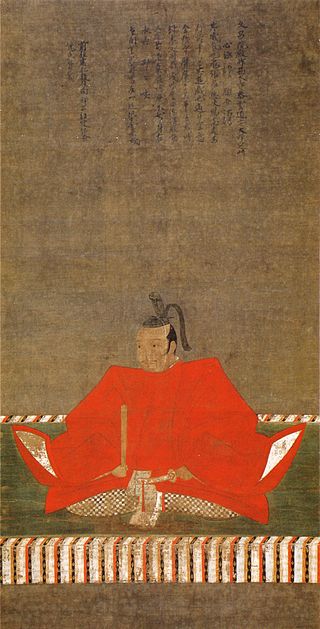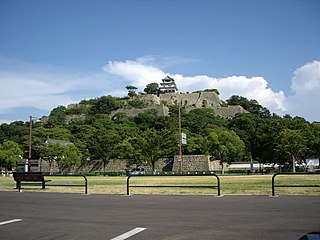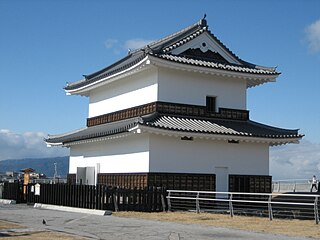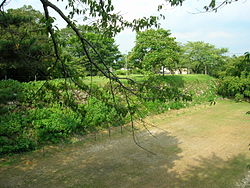
Okudaira Nobumasa, also called Okudaira Sadamasa, was a Japanese daimyō of the Sengoku and early Edo periods. Nobumasa's family considered their origins to have been associated with Mikawa Province. The clan was descended through the Akamatsu from the Murakami-Genji.

Matsumoto Castle, originally known as Fukashi Castle, is one of Japan's premier historic castles, along with Himeji and Kumamoto. It was the seat of Matsumoto Domain under the Edo Period Tokugawa shogunate. It is located in the city of Matsumoto, in Nagano Prefecture.

Hikone Castle is an Edo-period Japanese castle located in the city of Hikone, Shiga Prefecture, Japan. It is considered the most significant historical site in Shiga. The site has been protected as a National Historic Site since 1951. Hikone is one of only twelve castles in Japan with its original tenshu, and one of only five castles listed as a National Treasure.

Ueda Castle is a Japanese castle located in Ueda, northern Nagano Prefecture, Japan. At the end of the Edo period, Ueda Castle was home to a cadet branch of the Matsudaira clan, daimyō of Ueda Domain, but the castle is better known for its association with the Sengoku period Sanada clan. It was also called Amagafuji-jō or Matsuo-jō. The castle was designated a National Historic Site of Japan in 1934.

Fukuyama Castle, sometimes called Hisamatsu Castle or Iyō Castle was the castle of the Bingo-Fukuyama Han during the Edo period of Japanese history. The grounds of the castle have been designate a National Historic Site since 1964. The castle is located in Fukuyama Park in Fukuyama, Hiroshima near Fukuyama Station.

Imabari Castle is a Japanese castle in Imabari, Ehime, Japan. It was the center of Imabari Domain under the Edo Period Tokugawa shogunate and was ruled by a branch of the HisamatsuーMatsudaira clan through most of its history.

Sasayama Castle is an early Edo Period Japanese castle located in the city of Tamba-Sasayama, Hyōgo, Japan. It ruins have been protected as a National Historic Site since 1956.

Kanō-juku was the fifty-third of the sixty-nine stations of the Nakasendō connecting Edo with Kyoto in Edo period Japan. It is located in former Mino Province in what is now part of the city of Gifu, Gifu Prefecture, Japan.

Kanō Domain was a fudai feudal domain of Edo period Japan. The domain was centered at Kanō Castle, located in what is now part of the city of Gifu in Gifu Prefecture.

Kōriyama Castle is a flatlands-style Japanese castle located in the city of Yamatokōriyama, Nara Prefecture, Japan. Its ruins have been protected as a National Historic Site since 2023. It is No.194 on the list "Continued 100 Fine Castles of Japan".

Marugame Castle is an Edo Period Japanese castle in the city of Marugame, Kagawa Prefecture, Japan. It is located in the center of Marugame city, in former Sanuki Province on the island of Shikoku. During the Edo Period, it was the center of Marugame Domain, ruled by the tozama Kyōgoku clan under the Tokugawa Shogunate. The castle site has been protected as a National Historic Site since 1953. Marugame Castle is one of only a dozen Japanese castles to have an original wooden 'tenshu' built before 1860.

Ōgaki Castle is a flatlands-style Japanese castle located in the city of Ōgaki, Gifu Prefecture, Japan. During the Sengoku period, Ōgaki Castle was home to several of Toyotomi Hideyoshi's most trusted generals and relatives; during the Edo period, it was home to the Toda clan, daimyō of Ōgaki Domain, who dominated parts of the province of Mino under the Tokugawa shogunate. Other names for the castle include Bi Castle and Kyoroku Castle.

Tsu Castle was a Japanese castle located in the city of Tsu, Mie Prefecture, Japan. During the Edo period, Tsu Castle was home to the Sudo clan, daimyō of Tsu Domain, who dominated the provinces of Ise and Iga under the Tokugawa shogunate. The castle was also known as "Anotsu-jō" (安濃津城) after the ancient name for Tsu. The castle ruins are a Prefectural Historic Site.

Kuwana Castle is a Japanese castle located in Kuwana, northern Mie Prefecture, Japan. At the end of the Edo period, Kuwana Castle was home to a branch the Matsudaira clan, daimyō of Kuwana Domain. The castle was also known as "Ōgi-jō" (扇城) or "Asahi-jō" (旭城).

Takada Castle) was an Edo period flatland-style Japanese castle located in what is now the center of the city of Jōetsu, Niigata Prefecture in the Hokuriku region of Honshu, Japan. Under the Tokugawa shogunate, it was the centre of Takada Domain.

Tsuwano Castle was a Japanese castle located in what is now the city of Tsuwano, Shimane Prefecture, in the San'in region of far western Japan. Its ruins have been protected by the central government as a National Historic Site since 1942. In its early history, it was called Sanbonmatsu Castle or Ipponmatsu Castle. During the Edo Period, it was the center of Tsuwano Domain ruled by the Kamei clan; however, the administrative offices and daimyō residence were located at the base of the mountain to avoid the steep mountain paths.
Kamehime was the eldest daughter of Tokugawa Ieyasu, the founder and first shogun of the Tokugawa Shogunate of Japan, with his first wife, Lady Tsukiyama. She was the wife of Okudaira Nobumasa. She is primarily recognized as the eldest offspring of Ieyasu, notable for her active participation in the Siege of Nagashino and her significant role in the events leading to the downfall of Honda Masazumi.

Naegi Castle was a Japanese castle that formed the administrative center of Naegi Domain, a feudal domain of the Tōyama clan, located in what is now part of the city of Nakatsugawa in Gifu Prefecture, Japan. It also referred to as the Misty Castle, Naegi Castle was also known as "Akakabe Castle", as its walls were not white like many Japanese castles, but made with a reddish colored clay. The ruins have been protected as a National Historic Site since 1981.
Nagahara Goten (永原御殿) was an early Edo period Japanese castle located in what is now the city of Yasu, Shiga Prefecture, in the Kansai region of Japan. Its ruins have been protected as a National Historic Site since 2020.

Miyazu Castle is a flatland-style Japanese castle located in Miyazu, northern Kyoto Prefecture, Japan. At the end of the Edo period, Miyazu Castle was home to a branch of the Honjō-Matsudaira, daimyō of Miyazu Domain.
























